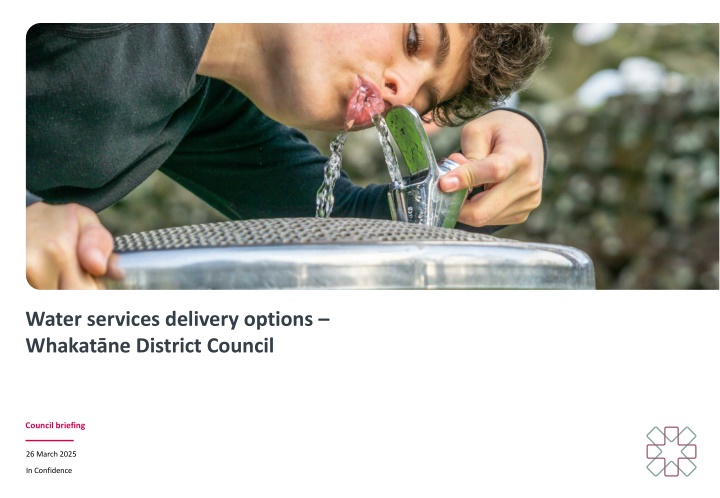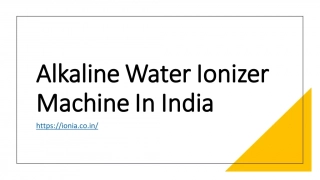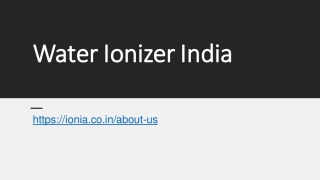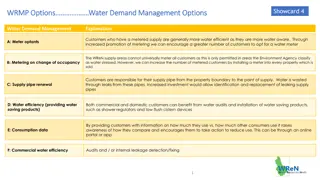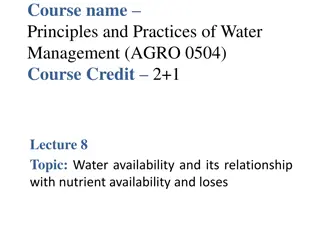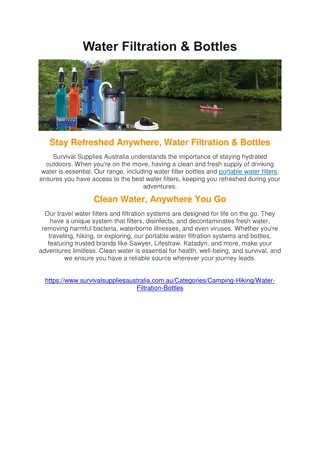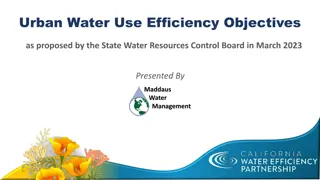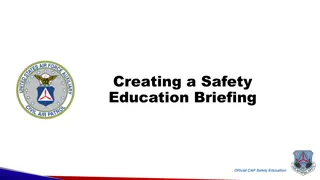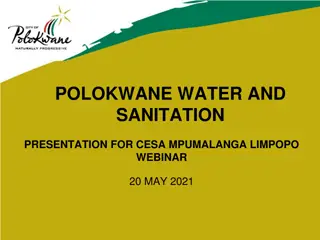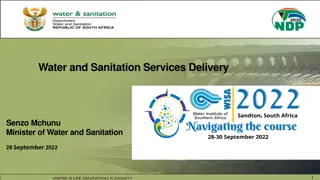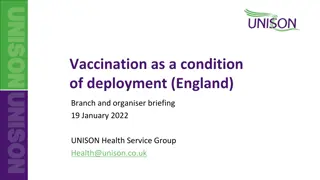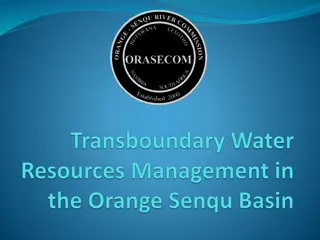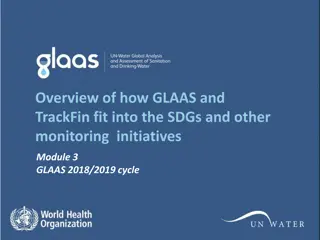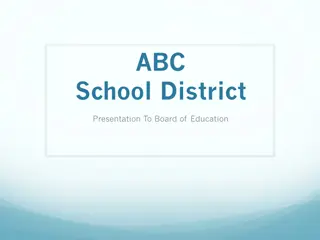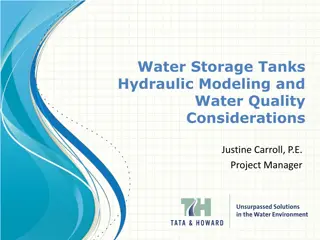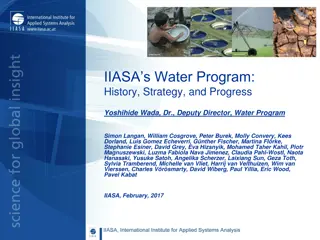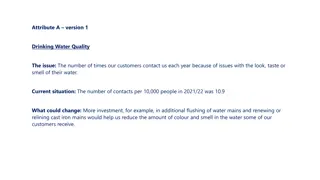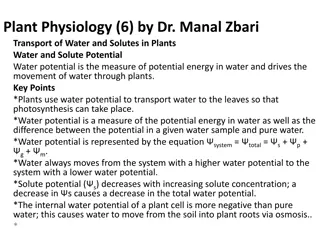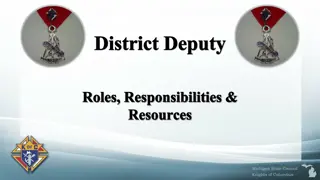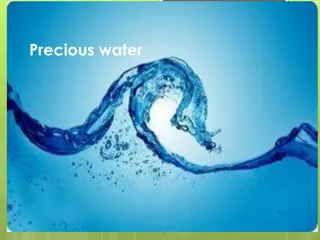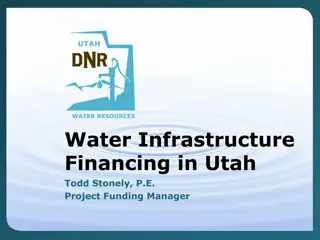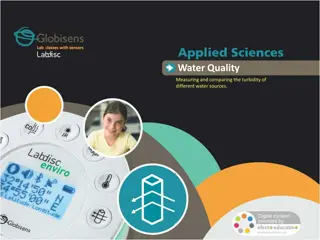Water Services Delivery Options Briefing for Whakatane District Council
This briefing provides guidance on preferred options for water services delivery, forming joint organizations, emphasizing consultation matters, and a recap of strategic challenges faced by the Council.
Download Presentation

Please find below an Image/Link to download the presentation.
The content on the website is provided AS IS for your information and personal use only. It may not be sold, licensed, or shared on other websites without obtaining consent from the author.If you encounter any issues during the download, it is possible that the publisher has removed the file from their server.
You are allowed to download the files provided on this website for personal or commercial use, subject to the condition that they are used lawfully. All files are the property of their respective owners.
The content on the website is provided AS IS for your information and personal use only. It may not be sold, licensed, or shared on other websites without obtaining consent from the author.
E N D
Presentation Transcript
Water services delivery options Whakat ne District Council Council briefing 26 March 2025 In Confidence
D R A F T Guidance sought from Whakat ne District Council As we further develop the consultation material, we need your guidance on some specific matters. 1. What is your preferred option? There are a number of judgements that Council will need to make to determine which option is preferred, particularly as the picture of costs and benefits changes over time. 2. How do you want to frame the options to form a joint water services organisation with other councils? Regardless of the Council s preference, you need to present the option of a joint water services organisation in public consultation. There are options for how you do this given there are different groupings of councils that WDC could join with to deliver water services under this option. 3. Are there any matters you wish to emphasise in consultation? Public consultation needs to provide sufficient detail to enable informed judgement while being accessible to the general public. Please advise if there are any specific matters you wish to emphasise in your consultation document. 2 W A T E R S E R V I C E S D E L I V E R Y O P T I O N S M A R T I N J E N K I N S I N C O N F I D E N C E
D R A F T Recap on WDC strategic context and challenges 1 2 3 Population growth, land use intensification and climate change Meeting regulatory requirements and renewing assets Sustainability and affordability challenges The capital expenditure programme to FY34 in WDC s Long-Term Plan would not meet regulatory requirements. Significant work has been undertaken to rework this programme and bring expenditure forward. Population growth will result in increased consumption of drinking water and discharge of wastewater. It will also generally result in land use intensification. The District faces compliance challenges in consistently meeting the Drinking Water Quality Assurance Rules and obtaining resource consents relating to drinking water and wastewater services. Significant investment is required and regulatory uncertainty remains despite publication of draft national standards for wastewater environmental performance. While less exposed than other districts, changes to demographics and consumer behaviour need to be monitored for their impacts on water use and discharge. However, this capex needs to be funded through a combination of borrowing and revenue. Capital expenditure needs to meet the expectations of regulators. Revenue collection needs to be affordable for ratepayers. Debt is subject to Local Government Funding Agency limits. Balancing the three is an ongoing challenge. Climate change will exacerbate demand on stormwater services during the most adverse weather events. It will also cause sea levels to rise. Infrastructure needs to be able to manage greater demands from climate change. There are a number of small community supplies that are vulnerable and present risk to Council. The Council faces an asset renewals backlog. 3 W A T E R S E R V I C E S D E L I V E R Y O P T I O N S M A R T I N J E N K I N S I N C O N F I D E N C E
D R A F T Recap: Summary of decisions in December In our advice to Council in December we recommended further considering two options: 1. an internal business unit (with possible shared services arrangements), and 2. a regional / sub-regional asset owning water organisation, with a grouping involving Tauranga City Council and Western Bay of Plenty District Council the most concrete option. At the 12 December meeting, Council received our report and: 1. Authorised the Chief Executive to: 1. Further explore opportunities with Tauranga City Council and Western Bay of Plenty District Council (and others) for a potential joint water services council-controlled organisation 2. Assess the existing Capex and Opex spend profile in the WDC LTP 24/34 to determine if a staged approach to achieving compliance is viable, including engaging with DIA, BOPRC and the Water Services Authority on requirements to comply with legislation. 2. Instructed the Chief Executive to write to the Minister requesting support from DIA to facilitate progress on joint arrangements with other councils, including potentially the appointment of a Crown Facilitator to help the Council explore potential joint arrangements with other councils. 3. Noted staff will return to Council by end March 2025 with two shortlist options for future water service delivery (which will be used for community consultation). This report provides further analysis of the two shortlist options to support a Council decision on its preferred option in preparation for public consultation. 4 W A T E R S E R V I C E S D E L I V E R Y O P T I O N S M A R T I N J E N K I N S I N C O N F I D E N C E
D R A F T Timeline Apr to Sep 2025 Mid-2025 From Feb 2025 Post consultation Legislation enacted Apr-May 2025 Council continues to develop WSDP following consultation. Key dates: - Council workshop on 28 May to consider feedback from consultation - Council meeting on 26 June to agree the preferred option for water services deliver Develop WSDP Legislation for new water services delivery system comes into force, including new economic regulatory regime and changes to drinking water, wastewater and stormwater regulatory approach. Decision on whether Council develops a stand-alone WSDP in parallel to a joint process. Public consultation This meeting Sep 2025 Council briefing Water service Delivery Plans submitted Public consultation from 17 April to 17 May. Council briefing to understand options ahead of Council resolution and to indicate preferred option. Develop WSDP on basis of guidance and templates issued by DIA. Council takes decision on future delivery model (stand-alone or joint). Local government elections interregnum 10 April 2025 Late 2025 Council considers final options assessment report Local government elections. Consultation document approved for release 5 W A T E R S E R V I C E S D E L I V E R Y O P T I O N S M A R T I N J E N K I N S I N C O N F I D E N C E
D R A F T Consultation requirements Engaging your communities Consultation must: Identify at least two options for delivering water services. Additional options may be identified. An assessment of the advantages and disadvantages of all options identified is required. Consult with its communities on its proposal, including on the impact on the council s rates, debt, levels of service, and charges for water services. If the council is considering a joint WSCCO option (whether establishing, or joining), it must also describe the implications for communities throughout the joint service area, and description of any accountability or monitoring arrangements the council will use to assess the performance of the WSCCO. Councils must consult on the anticipated model for delivering water services. The Local Government (Water Services Preliminary Arrangements) Act 2024 (the Act) requires the council to consult prior to determining the proposed model for delivering water services. 6 W A T E R S E R V I C E S D E L I V E R Y O P T I O N S M A R T I N J E N K I N S I N C O N F I D E N C E
Identifying the options for consultation
D R A F T Three options have been considered in further analysis 1. Internal water services unit WDC Councilors ELT Internal water services unit 2. WDC Shareholder Council Joint WSCCO WSCCO Board TCC West BOP WSCCO Shares owned in accordance with agreed allocation plan (jointly owned) Responsible for operational and financial decisions consistent with Statement of Expectations and statutory objectives Issues Statement of Expectations Appoints / removes water organisation Board members WBOPDC Councils support financing TCDC 3. WDC Shareholder Council Joint WSCCO WSCCO Board RLC East BOP WSCOO Shares owned in accordance with agreed allocation plan (jointly owned) KDC Responsible for operational and financial decisions consistent with Statement of Expectations and statutory objectives Issues Statement of Expectations Appoints / removes water organisation Board members Councils support financing DC 8 W A T E R S E R V I C E S D E L I V E R Y O P T I O N S M A R T I N J E N K I N S I N C O N F I D E N C E
Comparing the options
D R A F T Assumptions A capital programme of $215.7 million (today s dollars) over ten years is needed to be compliant with regulatory requirements Council can meet this expenditure (and associated consequential operating expenditure) through accessing debt and collecting water revenues Debt limits come from Council policy, the Local Government Funding Agency, and prudential management approaches Revenue collection is dependent on community s ability and willingness to pay 10 W A T E R S E R V I C E S D E L I V E R Y O P T I O N S M A R T I N J E N K I N S I N C O N F I D E N C E
D R A F T Key judgements to inform decision making Part 1: Comparative analysis against strategic objectives Part 2: Comparative financial analysis against key metrics Part 3: Comparative overview of ownership, decision making and accountability structures Part 4: Additional considerations (impact of remaining Council functions) 11 W A T E R S E R V I C E S D E L I V E R Y O P T I O N S M A R T I N J E N K I N S I N C O N F I D E N C E
D R A F T Your agreed strategic objectives STRATEGIC OBJECTIVES Effective and financially sustainable delivery of water services for the communities of the Whakat ne District, now and into the future Protects and promotes public health and the environment - meeting regulatory requirements Water services are resilient to natural hazards, seismic risk and climate change Integrated water services and infrastructure planning that promotes efficient, equitable, and integrated delivery Affordable fit for purpose service to consumers and communities that meets the needs, and expectations of the Whakat ne District Responsibilities to hap and iwi are met Remaining council operations are viable andcontinue to deliver on communities expectations This is a long-term decision Consider which of these are most important 12 W A T E R S E R V I C E S D E L I V E R Y O P T I O N S M A R T I N J E N K I N S I N C O N F I D E N C E
D R A F T Part 1: Summary of assessment against strategic objectives 1. 2. 3. In-house delivery West BOP WSCCO East BOP WSCCO Creation of dedicated ring-fenced water services unit within WDC. WDC joins WSCCO with TCC, WBOPDC, and possibly others. WDC joins WSCCO with Rotorua, Kawerau and p tiki. Effective and financially sustainable delivery of water services for the Whakat ne District communities, now and into the future Protects and promotes public health and the environment - meeting regulatory requirements Water services are resilient to natural hazards and climate change Integrated water services and infrastructure planning that promotes efficient, equitable, and integrated delivery Affordable fit for purpose service to consumers and communities that meets the needs, and expectations of Whakat ne District communities Responsibilities to hap and iwi are met Remaining council operations are viable and continue to deliver on communities expectations Legend: Does not meet objective(s) Consistent with objective but has some risks Moderate alignment to objective(s) Stronger alignment to objective(s) 13 W A T E R S E R V I C E S D E L I V E R Y O P T I O N S M A R T I N J E N K I N S I N C O N F I D E N C E
D R A F T Part 2: Comparative financial analysis against key metrics Forecast average cost per connection FY34 ($ real) WDC in-house $3,330 EBOP WSCCO $3,330 WBOP WSCCO $3,120 $0 $500 $1,000 $1,500 $2,000 $2,500 $3,000 $3,500 Peak annual efficiencies - comparison FY34 and FY44 EBOP joint WSCCO (FY34) 5.4% FY34 WBOP joint WSCCO (FY34) 8.4% EBOP joint WSCCO (FY44) 14.4% FY46 WBOP joint WSCCO (FY44) 23.3% W A T E R S E R V I C E S D E L I V E R Y O P T I O N S 14 M A R T I N J E N K I N S I N C O N F I D E N C E
D R A F T Part 3: Ownership, decision making and accountability EL EM EN T I N T ER N A L B U S I N ES S U N I T W ES T B O P JO I N T W A T ER C C O EA S T B A Y O F P L EN T Y JO I N T W A T ER C C O Council-owned (internal division) Owned by WDC and other participating councils Ownership structure Council oversight Shareholder councils Governance arrangements Elected members The Shareholder Council would issue a Statement of Expectations Operational and financial decisions sit with the Water Organisation Board Decision making Accountable to elected members and the public through existing mechanisms Reports to owners quarterly, prepares an audited annual report, acts consistent with statutory objectives. Accountability Through access to councillors and submissions If WDC is involved in establishment, it can influence the mechanisms included in the design of the organisation Community engagement and consultation Access debt via the LGFA subject to limits Final approach to be considered in next phase of reform WDC contribution to population and connections depends on mix of councils Water organisation charges water users, with borrowing of up to 500% of revenue from Local Government Funding Agency Allocation of costs, revenues and efficiencies High Increasing confidence that a grouping based around TCC and WBOPDC will emerge No confidence that an East BOP joint arrangement will emerge in the short term Confidence in delivery, establishment Shared services arrangements Mix of participating councils impacts efficiencies and dynamics Additional considerations Difficult to maintain affordability over time Risk that funding is prioritised to needs in other districts Depends on willingness of other councils to participate Risks 15 W A T E R S E R V I C E S D E L I V E R Y O P T I O N S M A R T I N J E N K I N S I N C O N F I D E N C E
D R A F T Part 4: Rest of Council considerations Decisions on how water services are delivered will have follow on implications for the rest of the Council s functions. WDC needs to consider whether existing service delivery arrangements will (i) be sustainable in the long-term; and (ii) continue to meet community expectations regarding levels of service and affordability. Net debt to revenue (LGFA) 450% 400% 350% 300% 250% 200% When water services remain inhouse, the Council s overall debt position is expected to become significantly constrained by water debt, unless general rates are increased to create additional borrowing capacity and financial flexibility to deal with potential future shocks. 150% 100% 50% - The removal of water service delivery would significantly improve the overall financial position of council as measured by the debt to revenue ratio, notwithstanding that council would have to jointly and severally guarantee the liabilities of the water CCO. Net debt to revenue - 3W Net debt to revenue - Council excl water Net debt to revenue - Council incl water Note, net water debt to revenue has been constrained in this scenario to 400%, requiring higher rates of increase in water revenue per connection in the first half of the current LTP period. The current overhead allocation method should be revisited, simplified and made more transparent. Initial reviews as part of this work suggest options to establish a water CCO would give rise to limited stranded overheads, particularly if carefully managed through the transition. 16 W A T E R S E R V I C E S D E L I V E R Y O P T I O N S M A R T I N J E N K I N S I N C O N F I D E N C E
D R A F T Best option for WDC depends on what you value O P T IO NS CHO O SE O P T IO N IF Internal business unit with possible shared service arrangements (enhanced status quo) You are confident that the impacts on debt and affordability are manageable given the capex needed to meet regulatory requirements, and Council wants least change to status quo. 1 Our analysis suggests the impact on debt and affordability will be hard to manage. West BOP water services organisation You are confident there would be mutual benefits from partnering with others to establish a joint organisation, including confidence in investment prioritisation mechanisms, ability to achieve economies of scale, and ability for communities and iwi/hap to engage and have influence. 2 Advantages and disadvantages will depend on the final number and mix of councils involved. East BOP water services organisation You are confident there would be mutual benefits from partnering with others to establish a joint organisation, including confidence in investment prioritisation mechanisms, ability to achieve economies of scale, and ability for communities and iwi/hap to engage and have influence. 3 Advantages and disadvantages will depend on the final number and mix of councils involved. 18 W A T E R S E R V I C E S D E L I V E R Y O P T I O N S M A R T I N J E N K I N S I N C O N F I D E N C E
D R A F T Guidance sought from Whakat ne District Council As we further develop the consultation material, we need your guidance on some specific matters. 1. What proposal (preferred option) do you wish to consult on? There are a number of judgements that Council will need to make to determine which option is preferred, particularly as the picture of costs and benefits changes over time. 2. How do you want to frame the options to form a joint water services organisation with other councils? Regardless of the Council s preference, you need to present the option of a joint water services organisation in public consultation. There are options for how you do this given there are different groupings of councils that WDC could join with to deliver water services under this option. 3. Are there any matters you wish to emphasise in consultation? Public consultation needs to provide sufficient detail to enable informed judgement while being accessible to the general public. Please advise if there are any specific matters you wish to emphasise in your consultation document. 20 W A T E R S E R V I C E S D E L I V E R Y O P T I O N S M A R T I N J E N K I N S I N C O N F I D E N C E
D R A F T Summary of process Apr to Sep 2025 Mid-2025 From Feb 2025 Post consultation Legislation enacted Apr-May 2025 Council continues to develop WSDP following consultation. Key dates: - Council workshop on 28 May to consider feedback from consultation - Council meeting on 26 June to agree the preferred option for water services deliver Develop WSDP Legislation for new water services delivery system comes into force, including new economic regulatory regime and changes to drinking water, wastewater and stormwater regulatory approach. Decision on whether Council develops a stand-alone WSDP in parallel to a joint process. Public consultation This meeting Sep 2025 Council workshop Water service Delivery Plans submitted Public consultation from 17 April to 17 May. Council workshop to understand options ahead of Council resolution and to indicate preferred option. Develop WSDP on basis of guidance and templates issued by DIA. Council takes decision on future delivery model (stand-alone or joint). Interregnum 10 April 2025 Late 2025 Council considers final options assessment report Local government elections. Consultation document approved for release 21 W A T E R S E R V I C E S D E L I V E R Y O P T I O N S M A R T I N J E N K I N S I N C O N F I D E N C E
